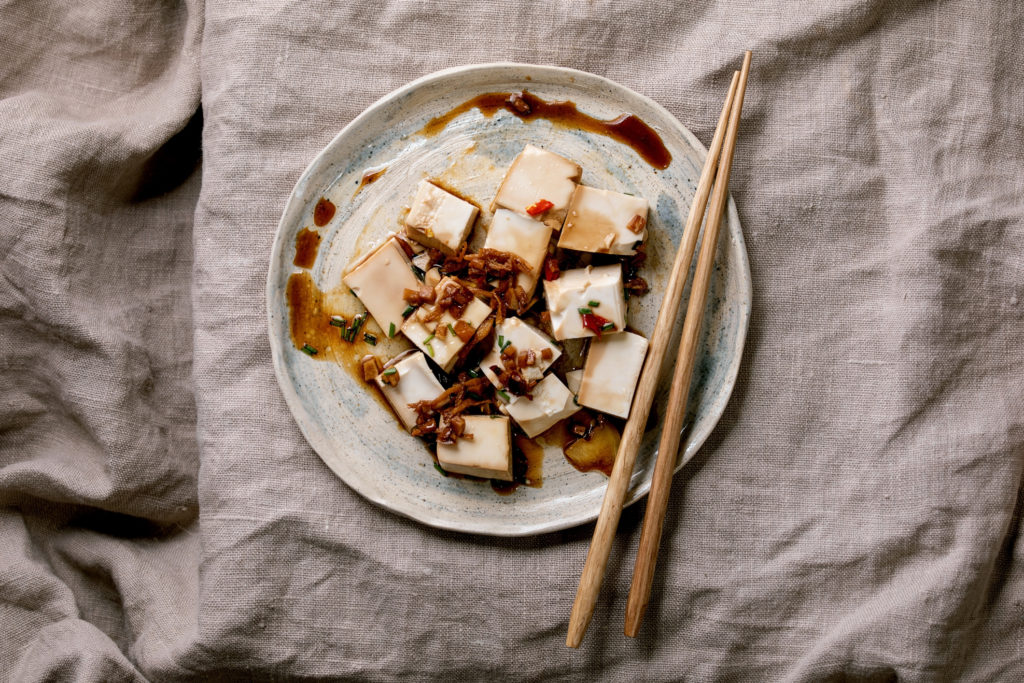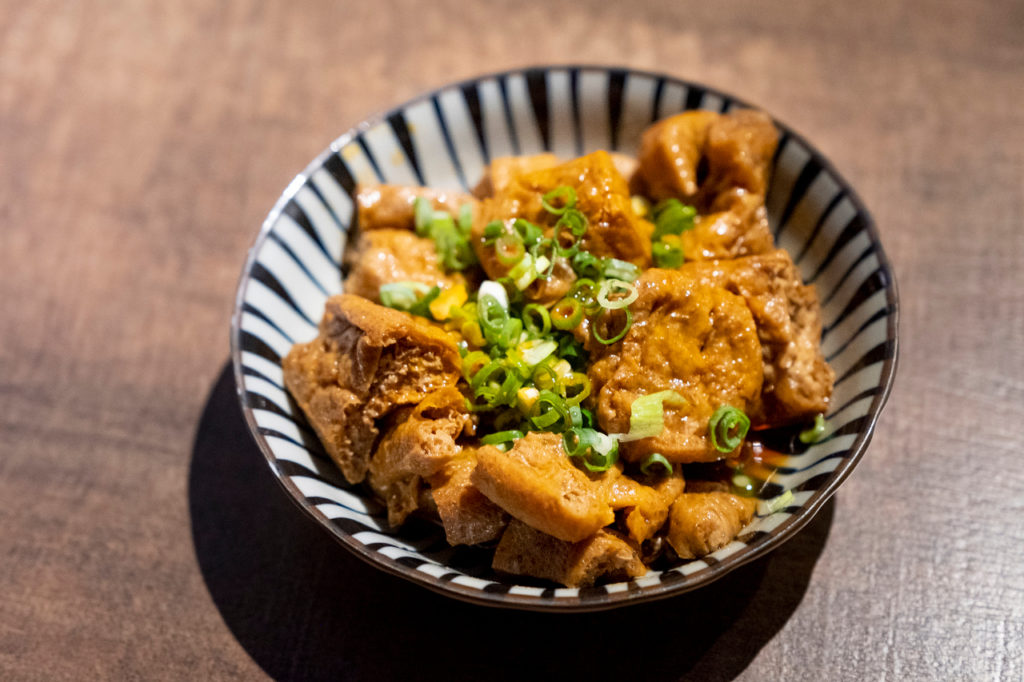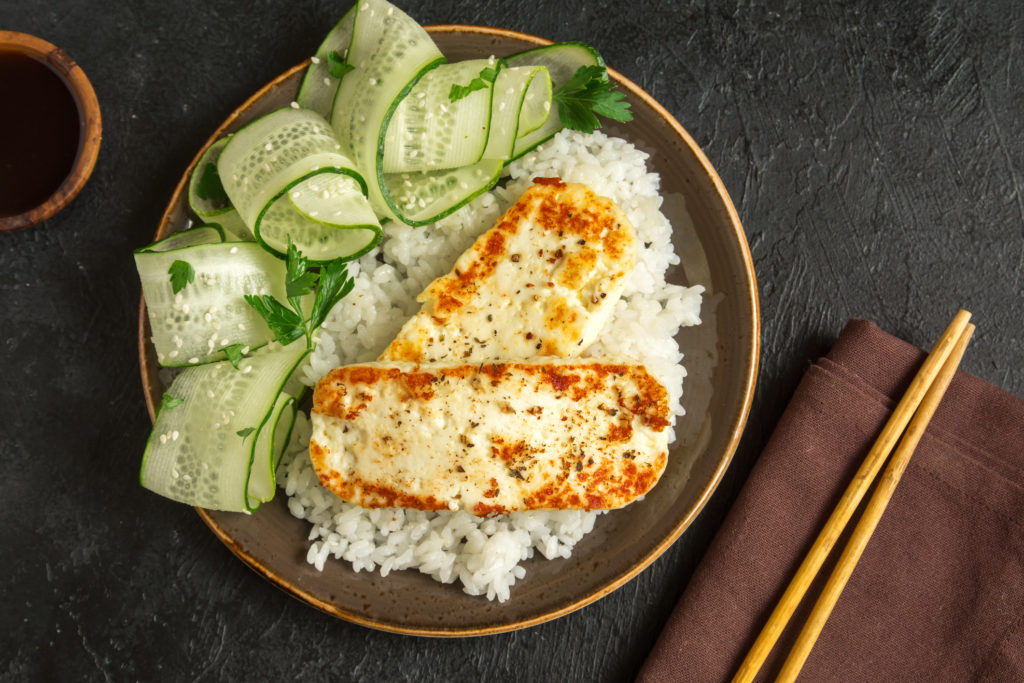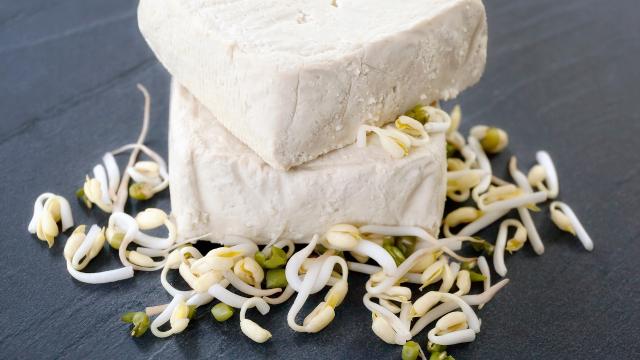We need to talk about tofu. As Beyond Meat and Impossible Burger mania sweeps the globe, the OG vegan protein is getting left behind — and I, for one, hate to see it. If you’re serious about reducing your reliance on animal products, tofu has the potential to change your diet—and life—for the better.
To some extent, I get why so many people, particularly meat-eaters, are resistant to the entire concept of tofu. Western culture has ruthlessly (and racist-ly) slandered the humble soy-based protein for as long as we’ve known about it, so a lot of us were basically programmed from birth to think it’s garbage.
I’m begging you to reconsider. When correctly prepared, tofu is a textural marvel, running the gamut from delicate and custardy to deep-fried and crunchy. Its unmatched flavour-absorbing powers make it a total chameleon; it truly can be anything you want it to be. I’ve loved tofu my whole meat-eating life, and I’m here to convert the naysayers. Welcome to my Tofu Manifesto.
You’re probably thinking about tofu all wrong

The biggest, wrongest tofu misconception is that it’s strictly a meat substitute. Sure, it can be that if it needs to—but tofu’s closest animal protein analogue is actually the egg. On their own, eggs are bland; it’s their ability to morph into a staggering array of forms and textures that makes them so special. However you like your eggs—fried crisp with lacy edges, scrambled soft with lots of butter, or cooked into a puffy, tender frittata—I’m willing to bet your preferences come down to texture rather than flavour.
The same is true for tofu, which is why I’m sceptical when people insist they don’t like how it tastes. Soft and silken tofu has a more noticeable soy milk vibe than the firm stuff, but for the most part, it adds no flavour whatsoever to a dish. Tofu only tastes as good as the sauce it’s served in—texture is basically the whole point.
It’s embarrassingly easy to make tofu taste amazing
Contrary to popular assumption, delicious tofu takes barely any work at all. In fact, all the usual hacks try way too hard: Pressing takes forever (and freezing even longer); marinating often yields profoundly mediocre results; a cornstarch dredge too easily sogs out. None of these techniques work particularly well on medium-to-soft tofu, and with the exception of marinating, they also offer absolutely nothing in the way of seasoning.
For all of these reasons and more, the salt water trick is the only tofu hack worth knowing. Hot, salty water is a tofu prep triple threat: It dehydrates firm tofu so it crisps up quickly, sets super-fragile soft tofu so it doesn’t fall apart, and seasons everything through and through. It also adds as much work to your dinner prep as boiling pasta. I’ll get into the specific techniques in a bit; for now, just know that the salt water hack promoted tofu from something I’d buy occasionally to a legit, can’t-live-without-it staple.
If you remain unmoved, I’ve collected my favourite tofu products and preparations in one place, starting with the most hater-friendly ones. This isn’t a recipe post—it’s all about the technique. (Where applicable, I’ll link to specific recipes that I used and explain how I adjusted them to work with tofu, with the hope that you’ll soon be doing the same.)
Even hardline sceptics love fried tofu puffs

Tofu puffs are cheap, delicious, deep-fried flavour sponges that need zero prep; in other words, they’re easy to love. You can toss them whole into curries and stews for a fun textural element, but I strongly recommend taking 30 seconds to slice them in half. With their honeycomb-like interiors exposed, these puffy little nuggets soak up sauce like nobody’s business—without compromising their crispiness.
To show them off, I made my favourite Maangchi recipe — cheese buldak, or fire chicken with cheese— with halved tofu puffs instead of chicken breast.
Those two ingredients are obviously nothing alike, but the swap totally works thanks to the insanely powerful sauce. Red-hot both in colour and spice level, surprisingly sweet, and with enough fresh ginger and garlic to put hair on your chest, it more than picks up the slack for something as bland as chicken breast or unseasoned tofu. Having made this dish with chicken dozens of times, I have to say—I prefer the puffs. Even when saturated with sauce, they stay light and puffy, which is the perfect contrast to the ultra-chewy texture of sliced rice cakes and melted mozzarella.
Pressed tofu does (most of) the prep work for you
As the name implies, pressed tofu has already been pressed to remove most of its moisture, resulting in a pleasantly toothsome texture. You can buy it pre-seasoned with soy sauce and five spice powder, but I like it plain so I can season it however I like.
Here, I whipped up a vaguely Spam-inspired mixture of roughly 2 tablespoons each of soy sauce and sugar, plus a teaspoon of garlic powder and a few shakes of smoky hot sauce (El Yucateco Black Label Reserve for life). I added some cubed pressed tofu and let everyone hang out about 20 minutes, flipping them around halfway through. You don’t need much marinade; a shallow layer is plenty.
I then used it to bulk up a super basic batch of fried rice with ginger, garlic, carrots, and frozen peas. The cubes got nicely crispy and charred on the edges, and were just what I needed to add some substance to a huge bowl of fried carbs.
Unseasoned pressed tofu also makes great vegan “paneer:” Cube it up and marinate in lemon juice with a few pinches of salt for 30 minutes, or longer if you have the time. As with regular paneer, you can pan-fry the tofu or leave it alone; either way, you’ll be surprised at how closely the marinated tofu mimics the texture and flavour of the real thing.
Medium-to-firm tofu needs a little TLC
This range of the tofu spectrum is the most recognisable and the least immediately appealing. I mean, just look at this:
In my experience, the variations between medium, firm, and extra-firm tofu are pretty meaningless, and I use them all interchangeably. Left uncooked, they all have a texture best described as “rubbery,” with no discernible flavour at all. Their highest calling is getting crispy in a hot skillet and doused in a flavorful sauce.
All you need to make crunchy pan-fried tofu is salt water, a good nonstick pan, and all of 20-30 minutes. That’s it. Here’s my usual procedure for a standard 500 gram block.
Before I do any other ingredient prep, I bring 2-3 cups of salted water and 2 teaspoons of table salt to a strong boil in a saucepan. Then I cut the heat, slide in my tofu, and let it sit while I prepare the rest of the recipe. After 15-20 minutes, I drain off the water and either pat the tofu dry on clean towels or leave it in the colander until I need it.
To get that crispy surface going, I coat my big cast-iron skillet with a thin layer of neutral oil and heat it over medium-high. I then add the tofu, spread it into an even layer, and leave it completely alone for at least 5 minutes.
Once the edges start to brown, I flip it over and do the same on the other side.
Boom. Done. Obviously, I used crumbled tofu here—it’s my favourite—but this works just as well with cubes, slabs, triangles, or any other shape you can dream up.
Don’t sleep on crumbled tofu
I know I said that tofu isn’t a meat substitute, but crispy tofu crumbles get really fucking close. In many cases, I prefer them to meat because they hold their shape—and a surprising amount of crunch—even when simmered for a long time. Sure, they don’t give you the specific richness you get with ground pork or beef, but with the right recipe you won’t miss it at all.
Speaking of the right recipe, Bon Appétit Test Kitchen director Chris Morocco’s spicy sweet sambal pork noodles are flawless—but, despite the name, I’ve actually never made them with meat. I only had tofu the first time I made them, and they turned out so well that I’m fine with never learning how they taste with pork.
I make the recipe exactly as written, except—obviously—I leave the pork out. Instead, I fry up soaked, crumbled firm tofu in a separate skillet while the sauce simmers, then dump ‘em in and toss everything together with cooked noodles. This cuts at least 30 minutes off the cook time without compromising on anything except porkiness, which I promise won’t even register.
You can also use tofu crumbles like ground beef. I usually throw in some minced onion and garlic in once the tofu is nice and crispy, then cook it down with a little tomato paste, taco seasoning, and cheap beer if I’ve got it.
It’s not beefy, exactly, but it tastes incredible in its own right—and makes a killer vegan-friendly crunchwrap filling.
You can roast tofu, too

Maybe you’d rather not spray your stovetop with oil in the name of crispy tofu. In that case, roasted tofu is for you. The results are directly comparable to pan-frying—they just take a little longer to get there.
Start with soaked, drained tofu, preferably cut into triangles or flat slabs so they’re easy to flip. Arrange on a clean towel and let them dry out while your oven preheats to 450ºF.
If you like, cut a vegetable of your choice into similarly-sized pieces and toss them with a tablespoon or two of neutral oil; I’m using kabocha squash here.
Place a sheet pan on the lowest oven rack. After about 3 minutes, add 2-3 tablespoons of neutral oil to the pan, put it back in the oven, and heat for another minute or two. Carefully transfer the tofu and vegetables to the hot oiled pan, return to the bottom rack, and roast for at least 20 minutes. Flip everything over and roast for another 15-20 minutes, until the tofu is super crispy on both sides and the vegetables are browned and soft.
You can eat the whole shebang straight off the pan—perhaps drizzled with spicy peanut sauce or chilli oil—but I added mine to a quick curry made with Maesri panang curry paste, palm sugar, and coconut milk. (Maesri is the only brand I’ve found that doesn’t use shrimp paste or fish sauce; if you usually avoid prepared curry paste for allergy or vegan reasons, give it a try.)
To be completely honest, the kabocha was a miss—the flesh was too dry, and the skin was super tough. The crispy roasted tofu, however, slapped. They can’t all be bangers; such is the nature of experimentation.
When you feel ready, silken tofu is there for you
The next stop on our tour de tofu is the most controversial, misunderstood one yet: Soft or silken tofu. Yes, it’s bland. Unseasoned coagulated soy milk isn’t going to blow your mind with super-concentrated umami or whatever. But when prepared correctly, soft tofu is more than just delicious—it’s absolutely sublime. I will go to bat for it all day long, and I would love to tell you why.
The dish that changed my mind about silken tofu came from Biwa, a now-closed izakaya-style bar in Portland. It was deceptively simple: A whole block of chilled silken tofu drizzled with sweet soy sauce and topped with bias-cut scallions, fistfuls of toasted sesame seeds, and paper-thin bonito shavings. I ordered it every time, and my friends would always be like—“Cold tofu? Why?” But if I could convince them to take a bite, they’d understand. It was like eating a deeply savoury panna cotta.
Unfortunately, my dearly departed Tofu Slab is no more—and my attempts to recreate it have been so unsuccessful that I’m forced to settle for the next best thing: Salt water-soaked silken tofu mounded on hot white rice and drowned in chilli oil, soy sauce, and black vinegar.
I’m not complaining. The salt water, once again, is key: It turns a cold, slimy block of tofu into a piping-hot savoury custard, which is the perfect canvas for condiments. Sure, there’s not much in the way of textural contrast, but the softness is so comforting and nice that I think a crunchy element would actually defeat the purpose. It’s a delicious, balanced, reasonably nutritious meal you can throw together in the time it takes to cook a pot of rice.
Putting it all together: All-tofu mapo tofu
Neglecting to mention mapo tofu in an article about tofu is basically journalistic malpractice. The iconic Sichuanese tofu dish is rich, meaty, spicy, funky, sour, and savoury all at once—and slicked with lip-numbing Sichuan peppercorn oil for good measure. It’s a top 3 dish for me; I make it all the time, usually using Maggie Zhu’s recipe from the Omnivore’s Cookbook.
Being a big vegetable fan, I’ve experimented with using minced veg—eggplant, mushrooms, and even carrots—in place of the traditional ground meat. But this time, I decided to follow my vision and make a variant I’m calling “Oops! All Tofu.” I approached this recipe just like the sambal noodles, swapping crispy tofu crumbles in for the ground pork—but this time, I also soaked some cubed soft tofu in a fresh pot of salt water while the sauce simmered away.
This was one of the most delicious things I’ve ever made. The nubbins of soft tofu were literally melt-in-your-mouth tender, while the crispy crumbles turned downright meaty as they soaked up the spicy, salty, rich sauce. It made me even more certain of all of the (correct) tofu opinions I just laid out before you and, if you’ll let it, it has the power to convert you too.
This article has been updated since its original publication.

Leave a Reply
You must be logged in to post a comment.